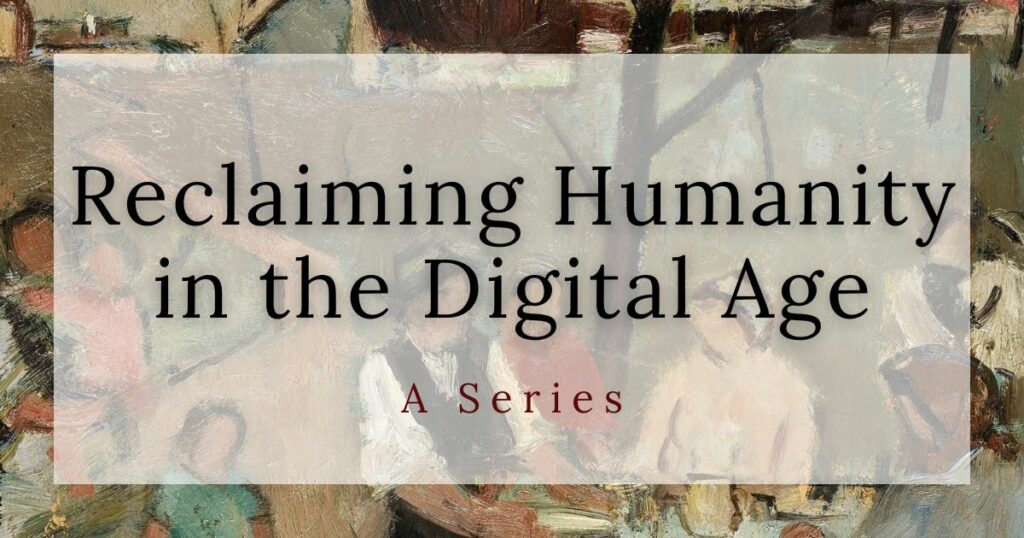This is the final installment in a six-part series, “Reclaiming Humanity in the Digital Age.”
By Joshua Pauling
Part 1 of this series tackled why now is the time to change our relationship with digital technologies, Part 2 presented crucial strategies for parenting, Part 3 explored coming of age in the digital world, Part 4 encouraged adults to lead the way in forming healthier habits and practices, and Part 5 highlighted the church’s vital role as an embodied, living alternative to the digital environment: a real, flesh and blood place where God meets man.
Now in Part 6, we look to the future. What lies next on the digital horizon? What principles should guide our thinking as each new technological frontier is opened? And what does Christianity have to say about it all? While there will be many foreseen and unforeseen technological dilemmas that demand careful ethical and theological reflection, two areas especially deserve our attention: transhumanism and AI. But first, it is important to see how these issues connect back to the perennial question of the nature of man.
The defining question of our time: What does it mean to be human?
Many contemporary theologians and philosophers have argued that our cultural and moral problems connect back to faulty views of humanity. For example:
- “If man is just a highly evolved mammal, then he is free to do whatever instinctually feels right for his personal happiness and survival.”
- “If man is autonomous and independent, in control of his own body and destiny, then he can do whatever he wants to his body.”
- “If man is just material stuff, then he is no different than a machine, and can be merged with the machine through machine-human integration.”
- “If man has evolved from lower beings, then he can continue that evolution by leveraging technology to transcend human nature and limitations.”
There are many more variations on this theme. But all of them highlight the necessity of properly answering the foundational question: What does it mean to be human? Christians have the answers to this question. Among many other things, Scripture teaches us that human beings are:
- Creatures of God with inherent limits that predate the fall, uniquely created in the image of God to share in His likeness and be His representatives on earth (Gen. 1–2).
- The unity of body and soul in one person, in a way that is so intertwined that it transcends our understanding. The material and spiritual aspects of the human person bridge the two realms of heaven and earth (Gen. 2:7; Psalm 8; 1 Cor. 15:47).
- Designed with bodies that are good and that have a purpose, as reflected in the body’s ordering towards communion with others (especially manifest in marriage) and ultimately with the Holy Trinity (Gen. 2:18–25, Eph. 5:25–33, Rev. 21:3).
- Creatures radically affected by the fall, which creates a doubleness in man: a deep-seated corruption that affects every aspect of our being, yet a remaining mystery and majesty in our nature as a work of God (Gen. 3, Gen. 9:6).
An understanding of human nature built on these foundational tenets equips us to better handle the challenges of the digital age now and into the future.
Transhumanism
At its simplest, transhumanism is the attempt to transcend human nature through technology. While this may seem like the stuff of science fiction, it is actively supported by many at the highest levels of Silicon Valley. Perhaps most recognizable is Elon Musk, who is involved in several projects with transhumanist undertones, including Neuralink, an effort to develop a computer chip that would be implanted into the human brain to augment human intelligence and achieve seamless brain-computer integration. Musk has said he aims “to achieve a symbiosis with artificial intelligence,” to develop a technology for “merging [humans] with AI” so that we won’t be “left behind” as AI systems become more advanced.[1]
Much more could be said about transhumanist leaders like Ray Kurzweil or Max More, or those who are pursuing forms of digital immortality.[2] But suffice it to say that transhumanism is no longer a fringe phenomenon. Its ideas are baked into much of the current discourse about technological advancement, genetic research and even many of the products and apps designed by tech companies.[3] Transhumanism’s impact becomes even more evident when we recognize that transgenderism fits under the larger umbrella of transhumanism. The same mindset that makes it plausible to erroneously think people can transcend their body by changing their sex also makes it plausible to think they can transcend their body in other ways. Furthermore, digital technologies make this all seem natural and intuitive because so much of life is already lived online through personally crafted identities that are disconnected from the body.
There are also religious dimensions to the transhumanist vision. In a certain sense, it is a distorted form of Christian eschatology; an attempt to achieve immortality through technological means that are outside of God’s ordained path to immortality through the person and work of Christ. As transhumanism is further mainstreamed, it will be vital for Christians to embrace their status as creatures made in God’s image with inherent limits and with bodies that are good.[4] Materiality isn’t something to transcend or escape but to treasure and embrace, for Christ Himself lives in His resurrected flesh, and so will we in the New Kingdom (Rom. 6:1–11; 1 Cor. 15:20–28).
Artificial Intelligence
Closely related to transhumanism is the race towards artificial intelligence. This has long been a human dream, from ancient pagan idols to 18th century automatons; from Shelley’s Frankenstein to Asimov’s I, Robot; from Joseph Weizenbaum’s original chatbot in the 1970s[5] to Sam Altman’s OpenAI and the push for AGI (artificial general intelligence). While recent progress in this field is certainly astounding, it speaks more to the intelligence and accumulated knowledge of the human designers and programmers than to any true creation of new intelligence. The computer systems don’t really know anything. No knowledge or meaning inheres in these AI systems, only the external, human knowledge they compile and the meaning we ascribe to them.[6]
Even though Christians should continually challenge the idea that AI is “intelligent” or that there is such a thing as machine “learning” in the human sense, AI very likely will increasingly impact every aspect of our lives. Economic disruptions will be substantial as many jobs are outsourced to AI. Education is already reeling as students and teachers turn to ChatGPT rather than doing the hard work necessary for human growth in wisdom and virtue. Relationships face new competition with the expansion of chatbots, AI companions, AI girlfriends/boyfriends, and AI playmates.[7] Even if AI is not truly conscious or sentient in any real sense, because humans anthropomorphize technology, people already are and will continue to consider AI as real beings with whom they develop real attachments. Is the church ready for this? What will we say to the parishioner who tells us they’ve developed an intimate relationship with a chatbot? What does pastoral care look like for someone who has fallen in love with an AI girlfriend? How should we respond to churches that incorporate AI for pastoral care or preaching?[8]
The AI chatbot that caters to your every whim and reinforces what you want to think about yourself is not doing anything for you — except making you more selfish, more self-absorbed, and more likely to objectify and manipulate others. You need real life with its suffering and sacrifices, with its giving and receiving in real relationships where you don’t always get what you want. Such things cause you to grow in wisdom and virtue in the process of sanctification. And herein lies perhaps the most insidious danger with AI technologies: They offer the false promise that you can skip the kinds of effort and hard work that actually develop the human capacities we need for a full and flourishing life. If we buy into this false promise, it is we who end up being deskilled, we who atrophy, we who lose the capacity to exercise those gifts.
The Necessity of Hard Decisions and Life Together
What lies on the digital horizon, and what is already here, require us to return to the foundational questions of human nature, the inherent risk and friction of human experience, and the glory of Christ’s incarnation in the flesh.
We need clear catechesis on what constitutes a human being. We must bring to bear all the resources of Christian theology, philosophy and ethics to clearly articulate boundaries and guiding principles. And, even more importantly, we need to provide something better than what is on offer: real-life, embodied relationships of love and care in the family and in the church. This messy, mundane miracle of life together provides the antidote to the simulated experiences of AI and the dreams of transhumanism by restoring the relationship we are all seeking: the reunion of God and man by grace through faith in Christ, to whom we are united in the sacramental life.
We need to live as creatures of God, rejecting technologies and ideologies that put forward visions of the human person that contradict Scripture and reality. We may have to opt out from the brain chip implant, the body enhancement, the genetic modification or the augmented reality glasses. We may have to give a hard no to incorporating certain aspects of AI into our personal lives, homes, schools and churches.
But none of this should come as a surprise: Christians have always been a peculiar people, a chosen nation, a royal priesthood (1 Peter 2:1–12) who live in the world but not of it (John 17:6–19). “For the gate is narrow and the way is hard that leads to life” (Matt. 7:14). Living the life of faith and becoming people of wisdom and virtue is slow and hard. It is much different from computation or calculation, much more than transactional inputs and outputs. Proverbs paints just such a picture of the wise man who attends to the way things are and delights in God’s Word. The wise man is not someone who can compute the fastest or knows the right facts, but one whose affections have been properly ordered, bringing knowledge of truth into wisdom in action. Wisdom is not only right and true, but beautiful and desirable (Prov. 3:15–18). The development of virtue occurs through the long process of learning and living in a body and within a community of bodies. And our families and churches are that community. This is a time of great opportunity for Christians to lead the way in reclaiming our humanity and helping others find what it means to be truly human again, to be restored to a right relationship with the Holy Trinity and one another, world without end.
[1] Elon Musk, cited in Sigal Samuel, “Elon Musk Reveals His Plan to Link Your Brain to Your Smartphone,” Vox, July 17, 2019, https://www.vox.com/future-perfect/2019/7/17/20697812/elon-musk-neuralink-ai-brain-implant-thread-robot.
[2] For example, the Terasem Movement seeks to achieve “transferred consciousness,” where a “conscious analog of a person may be created by combining sufficiently detailed data about the person (a ‘mindfile’) using future consciousness software (‘mindware’),” then it is “downloaded into a biological or nanotechnological body to provide life experiences comparable to those of a typically birthed human.” Similarly, there is Lifenaut, a “web-based research project that allows anyone to create a digital back-up of their mind and genetic code. The ultimate goal of our research project is to explore the transfer of human consciousness to computers/robots and beyond.” “Terasem Movement Foundation,” accessed January 8, 2024, https://terasemmovementfoundation.com/; “LifeNaut,” LifeNaut, accessed January 8, 2024, https://www.lifenaut.com/.
[3] For more on transhumanism, see Robin Phillips and Joshua Pauling, Are We All Cyborgs Now?
[4] For more on the theology of the body and the goodness of being a creature, see John Kleinig, Wonderfully Made, Kelly Kapic, You’re Only Human, Alan Noble, You Are Not Your Own.
[5] For more on this fascinating story, and how Weizenbaum came to be one of the biggest critics of AI, see chapter 17 of Phillips and Pauling, Are We All Cyborgs Now?
[6] For more on this, see chapter 2 of Phillips and Pauling, Are We All Cyborgs Now?
[7] For more on this see chapters 7 and 8 of Phillips and Pauling, Are We All Cyborgs Now?
[8] Some churches have already gone all-in on this: “In a Catholic church in Warsaw, Poland, sits SanTO, an AI robot which looks like a statue of a saint, and is ‘designed to help people pray’ by offering Bible quotes in response to questions,” while in Germany a Protestant church “has developed a robot called…BlessU-2, which…can ‘forgive your sins in five different languages.’” Paul Kingsnorth, “The Neon God,” The Abbey of Misrule, April 26, 2023, https://paulkingsnorth.substack.com/p/the-neon-god.






1 Peter 1:9-10 As humans we are a chosen people, a royal priesthood, a holy nation, a people belonging to God, that you may declare the praises of him who called you out of darkness into his marvelous light. In this world, we, are aliens and strangers, enemies to God and we are called to abstain from sinfuldesires, which are at war against our soul. Our mission in this age of “artificial intelligence” is live such good lives among the pagans that, though they accuse you of doing wrong, they may see your “good works” and give all the glory to God on the day that He visits us. Continue as you are doing, knowing that through faith, given to us by the Spirit’s gifts we live by the grace of our Lord and Savior Jesus Christ.
Living our Baptismal faith is this: We are buried daily with Christ Jesus into His death in order that as Jesus rose again from the dead, we too, will walk in a new life.” A new life, a real life, not an artificial life lived in artificial intelligence. Jesus is true, Jesus is real, and His love for all sinners, cleanses and restores us into the one True Faith of the One, Holy Christian and Apostolic Church.